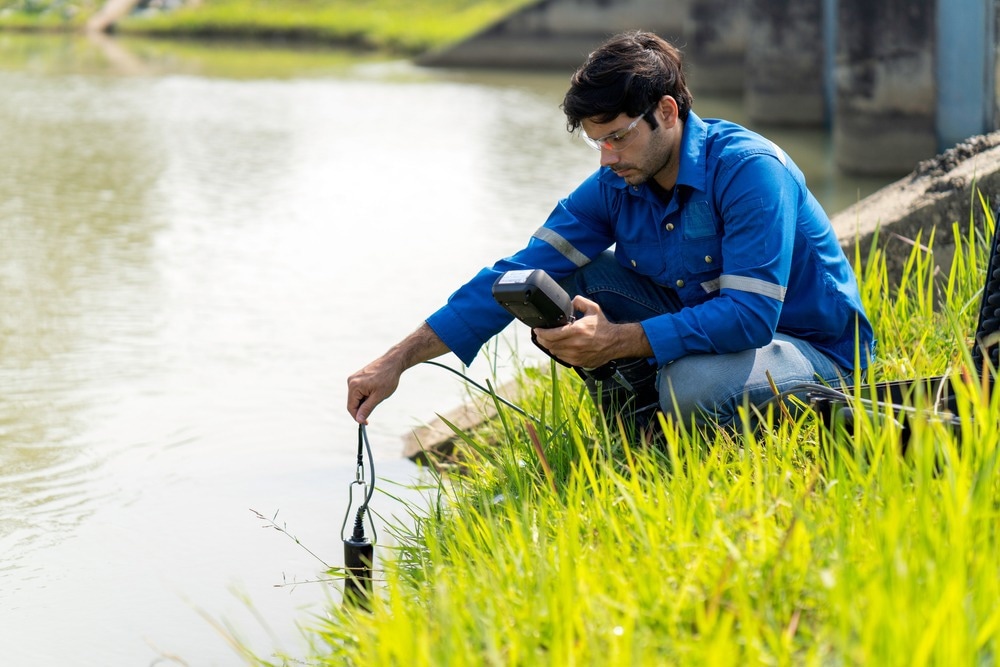Environmental monitoring stands as a sentinel for ecosystems, public health, and sustainability. Its import cannot be ignored; tracking pollutants, detecting hazardous substances, and preserving natural resources are crucial in an era of environmental challenges.

Image Credit: Chatchawal Phumkaew/Shutterstock.com
Among the technologies advancing environmental monitoring and protection, nanosensors have emerged as pivotal players. This article illuminates the growing role of nanosensors in environmental monitoring and protection, showcasing their potential to revolutionize how we safeguard our planet.
Understanding Nanosensors
Nanosensors, at their core, detect physical, chemical, or biological phenomena at the nanoscale and translate them into detectable signals. These devices rely on the unique properties of nanomaterials, such as their large surface area to volume ratio, which enables them to respond exceptionally to environmental stimuli.
Nanosensors come in various forms, each tailored to specific tasks. Optical nanosensors, for instance, detect changes in light properties, while electrochemical ones measure electrical changes induced by chemical reactions. Then there are mechanical nanosensors, responding to minute physical forces, and thermal nanosensors, sensitive to temperature fluctuations.
Materials and fabrication methods for nanosensors are equally diverse. Scientists employ carbon-based materials, like graphene, for their exceptional conductivity and strength. Nanocomposites and metal oxides also frequent the roster of materials due to their robustness and chemical versatility. Top-down lithography and bottom-up assembly are primary fabrication techniques, enabling the construction of nanosensors with precision and scalability.
Applications of Nanosensors in Environmental Monitoring
In air quality monitoring, nanosensors detect trace amounts of pollutants like NOx, CO, and volatile organic compounds (VOCs), which are pivotal for mitigating urban smog and industrial emissions. Their high sensitivity enables real-time air quality surveillance, contributing to healthier environments.
Water quality monitoring benefits immensely from nanosensors as well. They identify contaminants such as heavy metals, nitrates, and pathogens, safeguarding drinking water and aquatic ecosystems. By enabling in situ analysis, nanosensors offer a rapid response to potential hazards.
Soil quality monitoring is another realm where nanosensors excel. They ascertain the presence of toxic substances and monitor nutrients essential for agriculture. This information proves invaluable for sustainable farming practices and contamination prevention.
Commercial Implications of Nanosensors
The current market landscape for nanosensors has applications stretching across environmental and biomedical fields. In environmental monitoring, they are pivotal for both governmental and industrial entities, offering ways to oversee and ensure compliance with ecological regulations.
The nanosensors market has shown strong growth. Forecasts suggest a continuous upward trend. The market size reached approximately $790 million in 2022, and it is anticipated to rise to about $1,538.6 million by 2028. Several forecasts anticipate a compound annual growth rate (CAGR) ranging from 11.35% to 16.5%. Advancements in nanotechnology and reduced semiconductor sizes, which have improved sensor production, drive this expansion.
Economically, nanosensors reduce costs associated with traditional laboratory analyses. Ecologically, they enable more nuanced and immediate protective measures. However, regulatory challenges persist, with standards evolving to catch up with this fast-paced technology.
Nanosensors for Environmental Monitoring: Real-World Applications
A recent article in the journal Nature Nanotechnology discusses a project that illustrates the use of nanosensors for environmental monitoring. This project involves creating a scalable graphene sensor array tailored for real-time monitoring of toxins in flowing water. This technology provides instant information about the presence and levels of harmful substances, which is essential for safeguarding aquatic ecosystems and human well-being.
A research paper in Current Pollution Reports uses DNA nanosensors to identify environmental contaminants. These include unexplored pathogens, antibiotics, pesticides, genetically modified organisms (GMOs), heavy metals, and other harmful pollutants. DNA nanosensors are straightforward to design and exhibit strong sensitivity. DNA components and nanomaterials can be intentionally engineered to detect a variety of environmental pollutants.
Future Prospects of Nanosensors in Environmental Protection
Recent advancements in nanosensors indicate an increasing emphasis on enhanced sensitivity and their seamless integration with systems like the Internet of Things (IoT) and substantial data analysis. This collaboration holds the potential for creating a future where urban and rural landscapes incorporate real-time environmental monitoring into their very fabric.
The global environmental impact potential is staggering. Nanosensors could significantly contribute to protecting biodiversity, managing climate change effects, and reducing humanity's ecological footprint. Moreover, their integration with IoT and big data can lead to predictive environmental management, forestalling ecological crises before they escalate.
Sustainability and ethical considerations accompany the advancement of nanosensors. As we move forward, it is imperative to ensure that these technologies do not inadvertently contribute to the environmental burden and that their deployment is governed by ethical principles, particularly in data privacy and environmental justice.
Conclusion
Nanosensors stand as beacons of hope in environmental protection, offering unprecedented precision and efficiency in monitoring and safeguarding our planet.
The continued research and development in nanosensor technology promise a future where environmental monitoring is not just reactive but predictive and preventative.
The journey ahead is promising, and with mindful investment and exploration, nanosensors will continue to be instrumental in steering us towards a sustainable future.
References and Further Reading
IMARC, (2022). Nanosensors Market: Global Industry Trends, Share, Size, Growth, Opportunity and Forecast 2023-2028, s.l.: s.n.
Kumar, V. & Guleria, P., (2022). Application of DNA-Nanosensor for Environmental Monitoring: Recent Advances and Perspectives. Current Pollution Reports.
Mahmoud, A. E. D. & Fawzy, M., (2021). Nanosensors and Nanobiosensors for Monitoring the Environmental Pollutants. In: Waste Recycling Technologies for Nanomaterials Manufacturing. s.l.:Springer.
Sadik, O. A., (2014). Advanced Nanosensors for Environmental Monitoring. In: Nanotechnology Applications for Clean Water. s.l.:William Andrew Publishing.
Vikesland, P. J., (2018). Nanosensors for water quality monitoring. Nature Nanotechnology.
Disclaimer: The views expressed here are those of the author expressed in their private capacity and do not necessarily represent the views of AZoM.com Limited T/A AZoNetwork the owner and operator of this website. This disclaimer forms part of the Terms and conditions of use of this website.